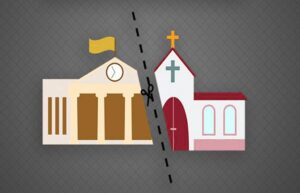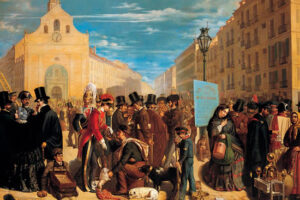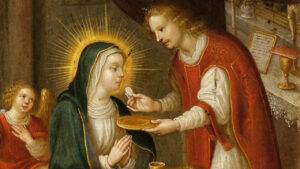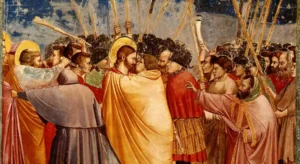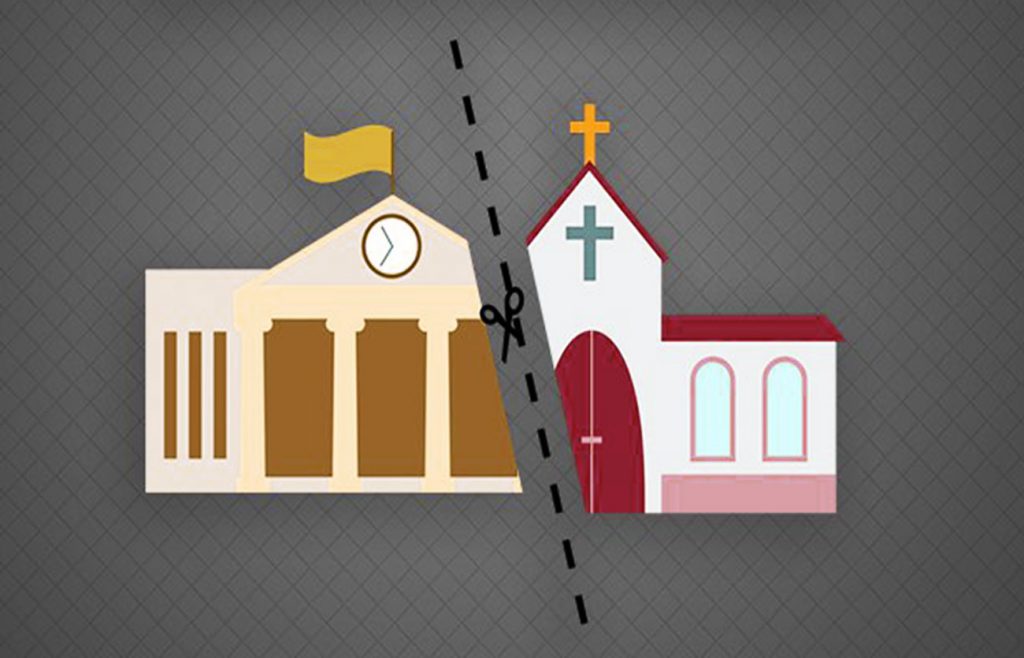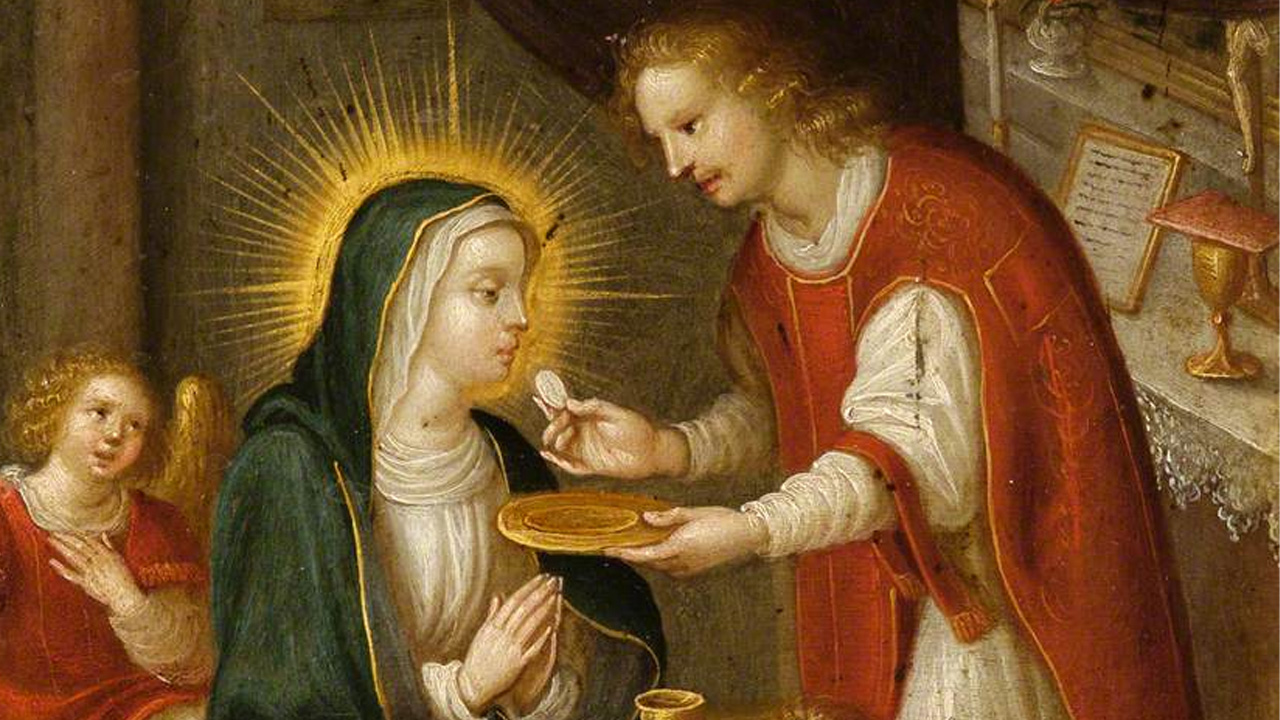Question: The question of the biblical canon: how was the list of inspired books formed?
Question: I would like you to clarify for me the books that Protestants removed from their Bibles. I would like to know what is meant by a “Canonical Book.” What are the criteria for accepting a book into the canon of the New Testament?
Answer:
We summarize our answer from the most well-known manuals of Introduction to the Bible[1].
Both Catholics and Protestants hold the Bible as the Word of God, and this Bible is composed of several books that all Christians recognize as inspired by God; however, these books were not all written at the same time. How was the list of inspired books formed? Who collected it and who determined it? This question is called the question of the “biblical canon” and is of enormous importance for determining the role of Tradition in its relationship with Sacred Scripture.
The study of the canon lets us know which and how many the inspired books are; it tends to prove the existence of the sacred catalog of inspired books, which has been transmitted to us by the Magisterium of the Church, and, at the same time, it aims to explain the history of its formation, that is, the evolution and vicissitudes it had to go through before the Church officially determined its canon. The Church took great care, right from the beginning, to distinguish the inspired books from those that were not, as apocryphal books soon began to appear that claimed to be inspired.
The problem of the biblical canon or catalog of inspired books is one of the most serious problems facing Protestantism, as a result of its rejection of Tradition and the Magisterium of the Church, because it faces an insoluble problem. Indeed, there is no “catalog revealed by God” within the Bible itself that says which books make up the Bible (besides, if it existed, there would remain the no less serious problem of demonstrating that said catalog is truly something inspired or revealed by God). That catalog (at least a large part of it, since Protestants reject a series of books), Luther received from the Catholic magisterium and Catholic tradition; paradoxically, by rejecting the Tradition and the Magisterium that endorsed the “canonical” value of those books, he kept the books (the ones he wanted, not all of them), but without being able to justify why they are canonical. It’s the same as if I claim that there is a planet with green men called Perelandra, to which I was taken by a flying saucer, and someone treats me as crazy and delusional but becomes convinced, nonetheless, that there is a planet with green men called Perelandra, which he has not seen nor will ever see! My authority is rejected, but what I affirmed based solely on my authority has been accepted! That is called “begging the question” or a “vicious circle” in logic. Well, this is what happens to Protestants when they accept the Bible but reject the authority that determines the existence and boundaries of a Bible (i.e., the existence of books inspired by God and their precise list). That is why this purely historical question is very illuminating.
The word canon comes from the Greek “kanôn“, and originally meant a straight reed used for measuring, a rule, a model. The Greek term “kanôn” is related to the words “káne“, “kánne“, “kánna” = cane, which probably come from Semitic languages, where we find the same root. Thus we have in Hebrew “qaneh” = “measuring rod”, in Assyrian “kanú“, in Sumerian-Akkadian “qin“. Consequently, the word “kanôn” transcribed into Latin as “canon“, designated in the proper sense a straight wooden rod, a rule used by carpenters. In a metaphorical sense, it indicated a certain measure, law, or norm for acting, speaking, and proceeding. This is the reason why the Alexandrian grammarians called “kanôn” the collection of classical works which, due to their purity of language, were worthy of being considered as models. The grammatical canons also constituted the models of declensions and conjugations and the rules of syntax.
The word is found four times in the New Testament, all in the writings of St. Paul (2 Cor 10:13.15-16; Gal 6:16).
Early ecclesiastical authors gave the word canon very varied meanings. From the middle of the 2nd century, “kanôn” is used in a moral sense, to designate the rule of faith (“ho kanôn tes pístêos“), the rule of truth (“ho kanôn tês alêthéias“), the rule of tradition (“ho kanôn tês paradósêos“) the rule of Christian life or ecclesiastical discipline (“ho kanôn tês ekklesías“, “ho ekklesiastikós kanôn“)[2]. The Latin Fathers and ecclesiastical authors also use formulas identical to those of the Greek Fathers, as can be seen already in the 3rd century in the writings of Tertullian and Novatian.
In this same sense, the decrees of the councils were called canons, insofar as they were the norms, the rules that the Church established for the more perfect regulation of its life. Faith, that is, revealed doctrine, is the rule that must serve to judge everything; it is the norm to which the faithful must adapt their lives, and since Sacred Scripture was considered, from the very origins of the Church, as the book that contained Revelation, the rule of faith and life, it became natural to speak of the canon of the Scriptures to designate this written rule, and they began to give the name canon to the collection of inspired books.
Therefore, the word canon, applied to Sacred Scripture, began to be used in the 3rd century. The first to use it is perhaps Origen, who states that the book The Assumption of Moses “in canone non habetur” (“is not in the canon”)[3]. The Monarchian Prologue, which some date to the 3rd century and others to the 4th, states that the canon begins with Genesis and ends with Revelation. The first who certainly applies the term canon to Sacred Scripture is Saint Athanasius (around 350 AD), who observes that The Shepherd of Hermas does not form part of the canon (“kaítoi me on ek tou kanônos“)[4].
From the noun canon is derived the adjective canonical (“kanonikós“). The first to use it seems to have been Origen, who wanted to designate with said adjective the books that were the regulators of the faith, the rule properly so-called of the faith, and constituted a well-determined collection by the authority of the Church. The term canonical also appears with certainty in canon 59 of the Council of Laodicea (around 360), in which it is established that, in the Church, “the non-canonical books are not to be read but only the canonical ones of the New and Old Testament”[5]. From the middle of the 4th century, it becomes common to call the Sacred Scriptures canonical (“kanonikai“)[6]. And since at that time there were already many apocryphal books, which constituted a grave danger for the Church and for the faithful because they presented themselves as inspired, it became necessary to fix the catalog of the Sacred Books, so that the faithful could distinguish the inspired books from those that were not. is gave rise to the formation of other expressions derived from canon, such as canonize (“kanonízein“), canonized (“kanonizómenos“), which in the ecclesiastical language of that time meant that a book had been “received into the catalog of the Sacred Books”[7]. And, in contrast, “apokanonízein” designated a book “excluded from the canon”.
Finally, from the adjective canonical was formed the abstract term canonicity, which expresses the quality of a book that, by its authority and origin, is divine and, as such, has been introduced by the Church into the canon of the Sacred Books.
All canonical books are inspired, although both concepts (canonicity and inspiration) are not completely identical: all canonical books are inspired (in determining them as “canonical”, what the Church judges is precisely that they are inspired); and it seems that there is no inspired book that has not been received into the canon of the Sacred Scriptures (that is, the list of inspired books that we possess is exhaustive). However, the reasons why a book is inspired and the reasons why it is canonical are different: it is inspired by the fact of having God as its author, and canonical insofar as it was recognized by the Church as inspired. Consequently, canonicity supposes, in addition to the fact of inspiration, the official declaration by the Church of the inspired character of a book. This declaration of the Church adds nothing to the internal value of the book, but it confers upon the sacred book an absolute authority from the point of view of faith and makes it an infallible rule of faith and morals. But it cannot be called canonical, strictly speaking, except after the declaration of the Church, made implicitly or explicitly (the Church’s declaration on the canonicity of a book does not need to be made solemnly or explicitly; it is enough that the Church has always held them as inspired in practice).
Although the criterion of canonicity is the acceptance by the Church of a book as inspired, it must be taken into account that not all were accepted from the first moment. Some were discussed for a long time (although they were known, venerated, and used) until the Church, in its function of magisterium, determined their canonicity by some solemn declaration. For this reason, Greek ecclesiastical authors used two terms to designate this distinction: books “universally accepted” (homologoúmenoi) and books “disputed” (antilegómenoi) or also “doubtful” (amphiballómenoi). In the 16th century, Sixtus of Siena (+ 1596) was the first to use the terms protocanonical, to designate the books that were received into the canon from the beginning (since everyone considered them canonical), and deuterocanonical, to signify those books that, although enjoying the same dignity and authority, were only received into the canon of the Sacred Scriptures at a later time, because their divine origin was called into question by many. It is important to keep in mind that the distinction of the Sacred Books into protocanonical and deuterocanonical, from the Catholic point of view, is not a distinction about their canonical value or sacred dignity (all are canonical and therefore inspired by God), but refers to a historical question: that of the time when they were received into the canon of the Sacred Scriptures (some from the start and others later, due to certain doubts that arose regarding their divine origin).
The deuterocanonical books are seven in the Old Testament (Tobit, Judith, Wisdom, Sirach, Baruch, 1 and 2 Maccabees. And the last seven chapters of Esther: 10:4-16:24, according to the Vulgate; as well as the chapters of Daniel 3:24-90; 13; 14) and also seven in the New Testament (Epistle to the Hebrews, Epistle of James, 2nd Epistle of Saint Peter, 2nd-3rd Epistles of Saint John, Epistle of Saint Jude, and Revelation. Some also consider the following fragments of the Gospels as deuterocanonical: Mk 16:9-20; Lk 22:43-44; Jn 7:53-8:11[8].
We must not confuse, therefore, the term deuterocanonical, as understood by the Catholic Church, with the qualification given to them in Protestantism. Among Protestants, the deuterocanonical books of the Old Testament are called Apocrypha (Catholics, on the other hand, designate with this name the books that, having certain similarities with the inspired books, were never received into the canon; Protestants call these same books Pseudepigrapha); instead, Protestants and Catholics agree on what they call deuterocanonical of the New Testament.
The terminology, therefore, is as follows:
| Catholics | Protestants |
| Deuterocanonical of the OT | = Apocrypha |
| Deuterocanonical of the NT | =Deuterocanonical |
| Apocrypha of the OT and NT | = Pseudepigrapha |
The Criterion of Canonicity. Just as to know the fact of the divine inspiration of a book, the only sufficient and effective criterion is the testimony of the Magisterium of the Church, likewise the only proper criterion of canonicity is the testimony of the Church. This is a doctrine already taught by the ancient Fathers, such as Origen and Tertullian and others[9] . The words of St. Augustine are well known: “I would not believe in the gospel if the authority of the Catholic Church did not move me to do so… We read in the Acts of the Apostles who succeeded the gospel, because the Catholic authority is what recommends both Scriptures to me”[10]. The testimony of the Church has been manifested to all the faithful through various channels: by the explicit testimonies of ecclesiastical writers, by synodal decisions, by the solemn proposition of the universal or ordinary Magisterium of the Church, by liturgical reading, and by all those means that the Church usually employs to propose Christian doctrine to the faithful.
Therefore, the testimony of the ecclesiastical Magisterium is necessary to know with certainty if a given book is canonical and inspired. Simple liturgical reading does not seem to be a sufficient criterion, because we know, from the testimony of various ancient Fathers, that other writings that never formed part of the canon of Sacred Scripture were also read in liturgical assemblies[11]. Nor is it enough that the doctrine of a book agrees with the doctrine of the apostles, to determine its canonicity, because many books can be found that perfectly agree with revealed doctrine and yet are not inspired. Not even the apostolic origin of a book seems to be a sufficient criterion, since in the New Testament there are books that were not written by the apostles themselves, but by their disciples (for example, the Gospels of Luke and Mark, or the Acts of the Apostles).
hat was the authority among the Jews that was responsible for distinguishing the Sacred Books (of our Old Testament) from those that were not? It was probably the priestly college, embodied mainly in the chief priests, who were the ones who exercised vigilance over religious matters. Other authors think that it would be the prophets who enjoyed the authority to judge whether a book was inspired. But it must be borne in mind that there were not always prophets in Israel. And precisely at the time when the canon of the Old Testament was fixed, the highest religious authority was held by the priesthood.
Protestants, by rejecting Tradition, found themselves forced to judge the canonicity of the Sacred Books by proper internal criteria. For Calvin, this criterion would be “the secret testimony of the Spirit”[12]; for Luther, the agreement of a book’s teaching with the doctrine of justification by faith alone[13]. Later orthodox Protestants, in addition to internal criteria, also admit subsidiary external criteria, such as the prophetic or apostolic charism of the author, the testimony of the ancient Church, the critically studied history of the canon. For liberal Protestants, since they practically do not admit inspiration, the question of the canonicity of the biblical books is also of no interest[14]. The books that the Church has preserved would only be those that practically imposed themselves in public reading as more suitable for the edification of the faithful. Modern Protestant theological renewal has led some of its main exponents to adopt new positions. One of the most noteworthy is that of O. Cullmann, who declares himself “absolutely in agreement with Catholic theology in the affirmation that the Church itself constituted the canon”, although his explanation of the Church’s authority to do this differs from the Catholic explanation. In any case, it is very interesting to see how within cultured and speculative Protestantism itself, the void created by the denial of a magisterial authority is evident.
We can ask ourselves if any inspired book has been lost. From the testimony of Sacred Scripture itself, we know of some writings coming from some prophet or apostle that have not reached us. In the Old Testament, there is repeated mention of the “Book of Jashar” (cf. Jos 10:13; 2 Sam 1:18), the “book of Samuel the seer”, the “chronicles of Nathan the prophet, and of Gad the seer” (cf. 1 Chr 29:29), the “prophecies of Iddo the seer” and the “books of Shemaiah the prophet” (2 Chr 9:29; 12:15). The New Testament also speaks of an epistle of Saint Paul to the Corinthians (cf. 1 Cor 5:9)[15] that seems to have been lost, and of another to the Laodiceans (cf. Col 4:16)[16]. If we consider these writings as inspired, we would have to admit that inspired books have in fact been lost. But to know their inspiration, one would have to possess the testimony of the Church, which is the only sufficient criterion to know it. The Magisterium of the Church, however, has said absolutely nothing about the inspiration of these books. And since the criterion of prophetism or apostleship is not sufficient to know the inspiration or canonicity of a given book, we are not in a position to affirm that some inspired books have in fact been lost. Hence, some Catholic authors firmly deny such a possibility. Their reasoning is as follows: biblical inspiration is not a private charism, given for the good of an individual, but it is a social charism, destined for the good of a society, which is the Church founded by Christ. Consequently, the destination of the inspired writing for the Church would enter into the essential elements of biblical inspiration, as the First Vatican Council clearly teaches[17]. Taking this principle into account, it does not seem possible to affirm that an inspired book was lost before reaching the Church. Nor could it be said that the loss occurred after being received by the Church, since that would accuse the Church of infidelity to its divine mission as guardian of the sources of revelation. However, in our opinion, a distinction must be made in this question between a book that is only inspired and a book that is inspired and canonical. Regarding the latter, it does not seem possible that a book recognized and declared as inspired by the Church has been lost. In this case, one would have to admit that the Church was not the faithful guardian of the revealed deposit. On the other hand, one could admit that an inspired book was lost before the official and universal recognition of the Church. It is true that inspiration, as a charism, was given to the human author with a view to the religious good of the community, but it is very possible that an inspired book was destined exclusively for a specific religious community of the first centuries, and, once its purpose was fulfilled, it disappeared before the recognition of the universal Church arrived.
One could also admit that over the centuries, some fragments of the inspired books may have been lost. But on the condition that these fragments are not of substantial importance for revelation. On the other hand, the history of the text clearly shows that the sacred text has come down to us substantially intact.
Our exposition could continue with the history and vicissitudes of the canon of the Old and New Testaments, explaining the most ancient testimonies in which the complete canon already appears or the exceptions of some books (for example, the absence of the letters to the Hebrews, James, 2 Peter, and 3 John in the Muratorian Canon, around 200 A. D., in Rome; the absence only of Hebrews, James, and Jude in the Mommsenian Canon around 260 A. D., in Africa; or the sole exception of Revelation in the lists given by St. Cyril of Jerusalem, St. Amphilochius – end of the 4th century – in Asia Minor) and their explanations (in some cases due to the use made of some passages by the Montanist and Novatian heretics, such as the appeal to Hebrews 6:4ff to speak of the irremissibility – that is, impossibility of forgiveness – of sins). I refer those who wish to enter into these interesting details to the biblical studies indicated in the bibliography. I believe that this is not the substance of the problem (although it is undoubtedly not without interest and importance). The key is the identification of the need for the “receptive” authority of the Church regarding a book as “inspired”, to determine it as canonical. If this is accepted, the question of the moment when the authority of the Church makes this receptive act (whether from the first moment of its composition, or a short time later, or after some centuries) is secondary; the Church, through its magisterial authority (conciliar documents, solemn papal affirmation, common use of the faithful never contradicted by those who have the office of magisterium, etc.), settles all questions by determining it. If this criterion of authority is not accepted – as Luther and Calvin and their followers did – one falls into the arbitrariness of subjectivism and accepts the books one wants, the passages one wants, and gives them the meaning one wants; one rejects the books one does not like or that are bothersome, the passages one does not like or that are bothersome, or the meaning that may not be liked or is bothersome; it is the principle of biblical anarchy which necessarily gives rise to sectarianism, the cracking of the unity of faith, and constant fragmentation into new denominations and religious groups; a phenomenon from which the Protestant world suffers.
I conclude with this testimony from Bob Sungenis, a former Protestant, which may be important for many people: “I found an indisputable example of the infallibility of the Catholic Church when I began to reflect on the question of the canon of Scripture: how the books of the Bible were defined, a point often ignored by Protestants. There is no ‘inspired index’ in the Scriptures. The decision about which books should be included in the Bible and which should not be included was made by the Catholic Church at the councils of Hippo (393 AD) and Carthage (397 and 419 AD)[18]. These decisions were later ratified and formally promulgated by the ecumenical councils of II Nicaea (787 AD), Florence (1440 AD), and Trent (1525-1546 AD). One of the books that helped me the most to understand this was Henry G. Graham’s book, Where We Got the Bible[19]. The Bible does not indicate which books should be included, and since Protestants do not believe that the Church has infallible authority to decide which should be included and which should not, they face a canonical dilemma. And thus they are forced to the logical, but heretical, conclusion that there may be inspired books that should be in the Bible but were not included by error, and that there may be uninspired books in the Bible that should not be there but were added by error. Martin Luther, for example, wanted to remove the books of James, Hebrews, 2 Peter, and Revelation because he believed they had been added by error. If it had not been for the persuasion of his contemporaries, these books would easily have been removed from Protestant Bibles.
By holding the theory of the ‘canon of fallibility’, Protestants cannot have infallible certainty that the Bible they hold in their hands is, in fact, the true Bible. The problem of the canon is a philological problem without a solution for Protestants. Because if one cannot have certainty about which books belong to the Bible, how can one presume to use it ‘alone’ as a trustworthy guide of saving faith in God? […] The truth is that Protestants are living on borrowed capital from the Catholic Church, because the Catholic Church infallibly recognized, under the divine direction of the Holy Spirit, the canon of the Scriptures. Every time Protestants quote the Bible, they unwittingly place their trust in the infallible divine direction granted to the Catholic Church by Christ”[20].
Fr. Miguel A. Fuentes, IVE
[1] Cf. For example, Manuel de Tuya–José Salguero, Introducción a la Biblia, Tomo I, Biblioteca de Autores Cristianos, Madrid, 1967, pp. 323-334.
[2] Clement of Rome, St. Polycrates (according to Eusebius), St. Irenaeus. Some authors often attribute the meaning of catalog, list, or inventory to the term canon, and it is customary to cite as examples the “kanôn basilêon” of Claudius Ptolemy (around 150 AD), which is a catalog of Assyrian, Babylonian, and Persian kings, and the “chronikoí kanônes” of Eusebius, which comprise synchronized tables of the various peoples of antiquity. However, even though these “kanônes” of Ptolemy and Eusebius are lists, they rather carry the meaning of a rule or standard, as they were dates, chronological measurements that served as the basis for chronological systems. If canon now has the meaning of list or catalog in ecclesiastical language, this is relatively recent and, furthermore, is a secondary meaning. The formal meaning is that of a rule, norm, or model.
[3] In his Homilies on Joshua, 2,1. However, we only have a Latin translation of this work by Origen; because of this, we do not know if he used the term ‘kanôn’ or rather ‘endiáthetos’.
[4] Decr. Nic. Syn. 18.
[5] Cf. Enchiridion Biblicum (EB) 4th edition (Rome 1961), n. 11.
[6] Cf. St. Jerome, Praef. In libro. Salom.; Priscillian, Lib. Apol. 27, etc.
[7] Cf. Origen, In Matth. 28.
[8] However, doubts about these texts have arisen only in our days among critics, due to the fact that these passages are missing in some ancient codices and versions.
[9] Cf. Origen, In Lc. Hom., 1; Cf. in Eusebius, Hist. Eccl. 6,25,35; Tertullian, Adv. Marc. 4,5.
[10] St. Augustine, Contra Epist. Manichaei, 5,6.
[11] From St. Dionysius of Corinth we know that the epistle of St. Clement of Rome to the Corinthians was read in liturgical assemblies (cf. in Eusebius, Hist. Eccl. 4,23,11). In the churches of Asia, the letter of St. Polycarp was read (cf. St. Jerome, De viris illustribus, 17).
[12] Cf. J. Calvin, Institutio religionis christianae, l. 1, c. 6-8 (Basel 1536).
[13] Cf. O. Scheel, Luthers Stellung zur hl. Schrift (Tübingen 1902), p. 42-45; M. Meinertz, Luthers Kritik am Jakobusbreife nachdem Urteile seiner Anhänger: BZ 3 (1905) 273-286.
[14] Cf. H.H. Howorth: JTS 8 (1906/07) 1-40.321-365; 9 (1907/08) 188-230; E. von Dobschütz, The Abandonment of the Canonical Idea: The American Journal of Theology, 19 (1915) 416s.
[15] Some authors want to discover vestiges of this lost letter of St. Paul in 2 Cor 6:14-7:1.
[16] The epistle to the Laodiceans would have to be identified, according to many authors, with the epistle to the Ephesians, which originally would have had in the initial greeting “in Laodikéia”. These words would have been suppressed – according to Fr. J. Vosté – because of the terrible reprimand that the author of Revelation launched against the church of Laodicea (Rev 3:14ff).
[17] Enchiridion Biblicum, n. 77.
[18] I clarify that what Sungenis says here can be confusing. It is not properly speaking the decision of which books to include, but the decision to elaborate an official or canonical list of the inspired books; long before these Councils, those books were already accepted by the Church, some of them from the very moment of their composition, like the Letters of the apostles or the gospels.
[19] Where We Got the Bible, Rockford, Ill., TAN Books.
[20] Bob Sungenis, De la controversia a la consolación, in: Patrick Madrid, Asombrado por la verdad, op.cit., pp. 142-144.
Original Post: Here



